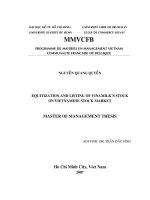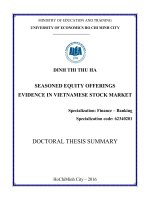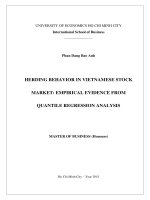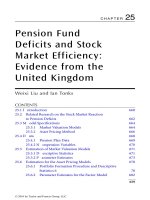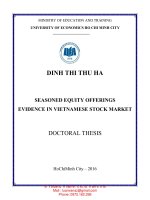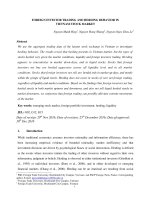Herding behavior in vietnamese stock market empirical evidence from quantile regression analysis
Bạn đang xem bản rút gọn của tài liệu. Xem và tải ngay bản đầy đủ của tài liệu tại đây (1.06 MB, 78 trang )
UNIVERSITY OF ECONOMICS HO CHI MINH CITY
International School of Business
--------------------------
Phan Dang Bao Anh
HERDING BEHAVIOR IN VIETNAMESE STOCK
MARKET: EMPIRICAL EVIDENCE FROM
QUANTILE REGRESSION ANALYSIS
MASTER OF BUSINESS (Honours)
Ho Chi Minh City – Year 2015
UNIVERSITY OF ECONOMICS HO CHI MINH CITY
International School of Business
--------------------------
Phan Dang Bao Anh
HERDING BEHAVIOR IN VIETNAMESE STOCK
MARKET: EMPIRICAL EVIDENCE FROM
QUANTILE REGRESSION ANALYSIS
ID: 22130006
MASTER OF BUSINESS (Honours)
SUPERVISOR: A.Pro.Dr. VO XUAN VINH
Ho Chi Minh City – Year 2015
ACKNOWLEDGEMENT
Firstly, I would like to express my gratefulness to my supervisor A.Prof. Dr.Vo
Xuan Vinh for his professional guidance, intensive support, valuable suggestions,
instructions and continuous encouragement during the time of research and writing
this thesis.
I would like to express my deepest appreciation to ISB Research Committee for
their valuable time as their insightful comments and meaningful suggestions were
contributed significantly for my completion of this research.
My sincere thanks also go to all of all of my lecturers at International Business
School- University of Economics Ho Chi City for their teaching and guidance during
my Master course.
Last but not least, I would like to thanks my family, whom were always
supporting me and encouraging me with their best wishes.
TABLE OF CONTENT
CHAPTER 1: INTRODUCTION................................................................................1
1.1. Research background ........................................................................................... 2
1.2. Research gap ........................................................................................................ 4
1.3.Research objectives ............................................................................................... 5
1.4. Research methodology and scope ........................................................................ 6
1.5. Research structure ................................................................................................ 7
CHAPTER 2: LITERATURE REVIEW ...................................................................8
2.1 Theoretical literature review ................................................................................. 8
2.2. Empirical literature review ................................................................................ 11
2.3. Measuring herding in financial markets ............................................................ 19
2.4. Hypothesis development .................................................................................... 25
CHAPTER 3: RESEARCH METHODOLOGY .....................................................27
3.1. Data collection and sample description ............................................................. 27
3.2. Regression model for testing the hypotheses ..................................................... 28
3.2.1 Regression model for testing the presence of herding bahavior in Vietnamese
stock market:.......................................................................................................... 28
3.2.2 Regression model for estimation the degree of herd in rising and falling
market: ................................................................................................................... 29
3.3. Regression methodology.................................................................................... 30
3.3.1. Research process ......................................................................................... 31
3.3.2. Quantile regression analysis ........................................................................ 31
CHAPTER 4: EMPIRICAL RESULT .....................................................................34
4.1. Decriptive statistics ............................................................................................ 34
4.2 Correlation analysis among variables ................................................................. 35
4.3. Regression result ................................................................................................ 36
4.3.1. Evidence on herd presence in Vietnamese stock market ............................ 36
4.3.2 Herding behavior in up and down markets .................................................. 38
4.4 Regression result from Quantile regression analysis .......................................... 39
CHAPTER 5: CONCLUSION AND IMPLICATIONS ......................................... 45
5.1. Conclusion.......................................................................................................... 45
5.2. Implications of herding behavior in Vietnamese stock market ......................... 46
5.3. Limitations and further research direction ......................................................... 48
REFERENCES ........................................................................................................... 50
APPENDICES ............................................................................................................ 55
LIST OF TABLES
Table 1.1: A summary of empirical evidence on herding behavior ............................ 15
Table 3.1: Summary of data observations used in the study ....................................... 27
Table 4.1: Descriptive statistics for daily market return and cross-sectional absolute
deviation (CSAD) for the Vietnamese stock market from 1/2005 to 4/2015 ............. 34
Table 4.2. Correlation among main variables ............................................................. 35
Table 4.3: Regression result of herding behavior in Vietnamese stock market .......... 36
Table 4.4: Regression results of herding behavior in rising and declining market ..... 38
Table 4.5: Analysis of herding behavior in Vietnamese stock market by quantile
regression. .................................................................................................................... 40
Table 4.6: A summary of research results ................................................................... 43
1
ABSTRACT
This study examines the herding behavior of investors in Vietnamese stock
market using data sample of 299 companies listed on Ho Chi Minh City Stock
Exchange. Using a least square method, the author finds evidence of herding presence
in rising and falling market when considering over the period of 2005 – 4/2015 as well
as in the periods of pre-crisis and post-crisis. By applying quantile regression analysis
to estimate the herding equation, the author find supporting evidence of herding during
the period studied as well as when splitting the market into two sub-periods; however,
the level of this trend is somewhat different conditional on quantile region.
Key words: herding behavior, Vietnamese stock market, quantile regression,
asymmetry.
2
CHAPTER 1: INTRODUCTION
This chapter presents the introduction of the study. It contains the research
background, research gap, research objectives, research methodology and scope and
research structure.
1.1. Research background
Traditional financial framework understands financial market by using models
which meet four foundation conditions: (i) investors are assumed to be rational, (ii)
market is efficient, (iii) investors make a decision on portfolios based on the rules of
mean-variance portfolio theory, and (iv) the expected returns are a function of risk
(Statman, 2014). Among them, the condition of rational investor is considered a
central assumption in which people make decisions reasonably and no biases in their
future prediction. However, the world economy has been shaken by the global
financial crisis in 2008, which originated from US and then expanded globally. As
soon as the crisis began, many economists and financial forecasters were no longer
able to analyze the bankruptcy of a variety of enterprises or banks in an intensive way.
The Vietnamese stock market is not an exception. From its foundation in 2000,
the Vietnamese stock market experiences “hot” growth and drastical fluctuation
without stability causing virtual stock matter. The value of VN-Index in 2000 of 100
points increases to 571 points after just one year and a half which astonishes economic
experts; however, this increment does not last long and rush to fall under 140 points in
2003, 150-200 points in 2004. The peak of growing phase is in the period of 20062007 as Vietnamese stock market has the highest growth of 1100 points
(approximately 145%) in Asia – Pacific region, even exceeding the Shanghai stock
market growth of 135%. Particularly, the VN-Index reaches to the record of 1170.67
points on March 12th, 2007 – the highest level in the world. This event makes stock
experts and market managers difficult to understand, thereby bring out the fear of
bubble formation in the stock market.
3
After a long time of increasing prices, the Vietnamese stock market has signal
to considerably decrease with the lowest record of 236 points on February 24th, 2009.
The happening in the market during this period is very complicated to anticipate. Once
again, economics experts doubt the precision of the efficient market theory. A paradox
is present that when the stock price is driven further from the fundamental value of
30% investors still trade constantly; whereas, when the stock prices decrease at an
attractive level in declining market investors massively sell stocks instead of buying. Is
it true that the Vietnamese stock market operation does not abide by any rules or there
are phenomena dominating the market which cause an unusual fluctuation? Failure of
the economists as well as their theories leads to a list of different questions in different
context: Are people rational? Or are they influenced by emotion such as fear, greed
which caused wrong decision?
Then, a new branch of financial research appears beside traditional financial
framework which helps economic experts and finance researchers partial explain
unusual fluctuation. Behavioral finance is a new strand of finance which investigates
the behavior of investors in financial market; in other word, it is a combination
between psychology and finance. It considers psychological factors as essential input
to financial analysis. Behavioral finance can elucidate several financial reactions that
contrast with standard financial theory and can thus make a contribution to avoidance
of mistakes as well as advancing investment strategies (Fromlet, 2001).
Previous researchers put sustained effort to understand investors’ behaviour in
the market as well as its impact on stock price. These investment behaviors are
influenced by some factors such as investors’ insight, criterion to measure investment
efficiency or market instability… In terms of psychology, investors are assumed to be
rational and always strive to optimize their actions but the fact that the rationality
appears to be inhibited by numerous cognitive biases, such as overconfidence, overoptimism, herding, representativeness … and so on. In this research, the author focuses
on the investment behavior of market participants regarding to their tendency to follow
the actions of others, which engages in herd behavior.
4
Herding behavior is defined as the trend of investors to imitate the actions of
others (Luu, 2013). This tendency is considered an inherent psychology of investors
but it becomes stronger as they have to make decision in a market condition with high
uncertainty and low transparency. Over last decades, research regarding this topic
receives an attention from scientists and empirical researchers. A numerous theories
are developed and empirical investigations are conducted to examine the presence and
reasons of this phenomenon in financial market. Researchers in this field believe that
the presence of herding behavior has impact on results derived from asset pricing
model because it influences stock price fluctuation, thus influencing risk and return of
stocks (Tan et al, 2008). Similar to speculation, herding behavior may be rational or
irrational. If market participants follow market consensus, the fluctuation is more and
more serious that can leads to instability in financial system, particularly in the period
of global crisis. In addition, herding behavior lasting so long can drive the stock prices
further fundamental value which causes destabilization. If investors are dominated by
sentiment such as greedy or fear of loss, they can trade in a “frenzied” way; as a
results, economic bubbles are created and may collapse the stock market. In sum,
herding behavior can lead to bad consequences of reducing the efficiency of market,
even result in the market instability and financial collapse.
Basing on these arguments, doing research about herding behavior can help
investors have an objective overview and be prudent when making investment
decision. Therefore, the author decides to do a research of “Herding behavior in
Vietnamese stock market: an empirical evidence from Quantile regression analysis”.
The study applies research model proposed by Chang, Cheng and Khorona (2000) and
modified by Chiang et al (2010) to investigate the presence of herd in Vietnamese
stock market.
1.2. Research gap
Several empirical studies have examined and detected the herding behavior in
many region throughout the world, form developed to emerging countries. For
5
example: Chang et al. (2000) find evidence of herding in Japan and South Korea but
no detection of herd in US and Hong Kong, Fu and Lin (2010) detect the presence of
herd in Chinese stock market which was in accordance with the results from Zhou
(2007) and Zhao (2011), Caparrelli, D’Arcangelis and Cassuto (2010) find the
evidence of herd in Italian stock market and Caporale, Economou and Phillipas (2008)
prove the existence of this trend in Athen, Greece…. In Vietnam, there are a little
research test for the existence of this tendency applying different model for detection.
Nevertheless, previous research concentrates on using Ordinary Least Square (OLS)
method to regress their model, which consists of a few drawbacks that may lead to
wrong results. Tran and Truong (2011) overcome this situation by using a more
powerful approach called GARCH; however, this method is still not optimal and
complicated in processing data.
The new point of this study is the choice of methodology. Instead of standard
method of OLS and dummy variable models which are pronounced in earlier literature
review, this research utilizes the model of Chang et al (2000) and applies quantile
regression analysis in empirical investigation. Quantile regression is considered a valid
alternative to the estimation of herding model such as Christie and Huang (1995) and
Chang et al (2000) (Jani, 2008).
In addition, preceding research investigated herding during very old period,
usually from the formation of stock market in Vietnam to five years later. At that time,
the number of securities was extremely small, even there were only 5, 10 and 20
stocks listed in the Vietnamese stock market in 2000, 2001 and 2002, respectively. The
data set of this research is collected from 2005, when Vietnamese stock market marked
an impressive growth, until now, in which the market is gradually matured. The
purpose of gathering the data set over the new period is to indicate a precise result with
current condition of Vietnamese stock market.
1.3.Research objectives
6
The substantial objective of this research is to test for the existence of herding
behavior in Vietnamese stock market through examining the relationship between the
level of equity return dispersion which measured by CSAD and the overall market
return.
The study proceeds to test for the asymmetric effect in case herd exists through
investigating whether to have differences in degree of herding behavior under various
market conditions.
1.4. Research methodology and scope
With the research objectives are set earlier, the thesis uses indirect approach by
examining the relationship between market return and stock return dispersion in order
to determine the existence as well as the level of herding behavior in Vietnamese stock
market. This research methodology is proposed by Chang et al (2000) and then
modified by Chiang et al (2010), which is applied commonly in research regarding
herd later.
The thesis conducts research based on data sample of 2568 daily observations
of 299 companies listed on Ho Chi Minh City Stock Exchange (HSX) over the period
of 2005-4/2015. Besides the traditional OLS method is used to test for the hypotheses,
quantile regression analysis is also used as a new point in choosing research
methodology to test for the regression model. The selection of quantile regression has
more advantages compared to OLS.
Ordinary least square approach is highly effective for intensive comprehension
about the central tendencies in a data set. But OLS analysis will be less useful for
understanding about the points which lie closer to the upper or lower tail of the
distribution within a population (Gowlland, Xiao & Zeng, 2009). Meanwhile,
Gowlland et al (2009) assert that quantile regression allows researchers to describe
more accurately behavior of the points lying towards the tails of the distribution.
Moreover, this method makes contribution to alleviating some of the statistical
7
problem of traditional OLS method such as outlier sensitivity, non-normal distribution,
errors in variables and so on (Zhou & Anderson, 2011).
1.5. Research structure
This research includes five chapters in total. The first chapter presents the
background of the research, researcher’s motivation and objectives doing this research
as well as general methodology and scope. Chapter two provides relevant academic
literature on herding which is separated into theoretical and empirical studies. The next
chapter presents detailed methodology in terms of the model used and the quantile
regression method as well as the data collection. The results of data analysis will be
discussed in chapter four which contains the results from using traditional Ordinary
Least Squares (OLS) approach and from applying the new method. Finally, chapter
five will summarize the main findings of research, drawing out some implications and
the limitations as well as further research direction are also mentioned.
8
CHAPTER 2: LITERATURE REVIEW
In this chapter, the theoretical framework and empirical investigation will be
discussed more clearly. Theoretical framework indicates general information about
herd such as definition of this trend in financial market, particularly in stock market.
Empirical investigation shows the detection of herding in numerous countries as well
as asymmetric effect consideration. Moreover, measurement of herding behavior in
financial market is also presented. In addition, the hypothesis is developed based on
some argument.
2.1 Theoretical literature review
Generally speaking, in economics and finance, herd or herding behavior means
the process participants are imitating other actions or base their decision on others’
actions (Spyrou, 2013). Nofsinger and Sias (1999) define herd as a tendency where
investors in the market trade in the same direction during the same time. Avery and
Zemsky (1998) suggest that investors who ignore their initial assessment and trade by
following the trend in the previous trade. Many other definitions regarding herd are
proposed by other researchers. For example, it is a mutual imitation (Welch, 2000), a
behavior converge to the consensus (Hirshleifer and Teoh, 2003) or a form of
correlated behavior (Hwang and Salmon, 2004). Luu (2013) suggests that herd effect
in financial market is identified as a phenomenon in which investors tend to mimic
others’ behavior.
In the security market, investors herd by making their investment decisions
based on the masses’ decisions of buying or selling stocks. If rational investors usually
follow their own belief that makes the market efficient, herding; in contrast, causes the
inefficiency of the market. In general, herding investors tend to act the same ways as
the groups who have little inadequate information about the surrounding circumstances
but behave in the same direction to get more secure (Caparrelli et al, 2010). Detecting
the existence of herd is considered carefully by practitioners because of the fact that
investors tend to ignore their own private information and usually follow majority of
9
the market, this leads to a consequence that the stock price deviates further from the
fundamental value; therefore, impacting on many good chances for investment.
What drives herding behavior is an important issue that needs addressing. The
reason behind this phenomenon may be diverse. Scharfstein and Stein (1990) argue
that the reputation concerns in labor market without perfect information environment
and insurance for any bad decisions may lead managers to follow each other’s actions.
Scharfstein and Stein (1990) come up with a model in which the labors are able to
understand their manager’ ability through investment decisions that manager makes.
Thus, in order to preserve their reputation before the employees when things go bad,
managers may rationally herd by ignoring their own private information and follow the
decisions of others. In other words, herding behavior is considered as an insurance
against manager underperformance (Rajan, 2006).
Trueman (1994) indicates that analyst abilities affect analyst compensation. The
expert tends to forecast earnings closer to prior earnings previously announced by
other analysts in an effort to mimic higher ability and achieve higher compensation.
Graham (1990) suggests that analysts more likely to herd are the one who
characterized by high reputation and low ability. Specifically, high reputation analysts
have greater motives to follow market consensus in order to protect their reputation
while low ability analysts are confused when there is strong public information
inconsistent with their private information and they know if they make forecasts
different from the consensus, they are more likely to be fired.
Another reason driving herding behavior is information-based issues. An
informational cascade takes place when individuals feel optimal to follow actions of
individuals before them without considering their own information (Bikhchandani et
al, 1992). For example, for investors who are newly enter the market at the later stage,
it may be an optimal decision to imitate trading behavior of previous investors since
they surmise that previous investors possess more accurate information. A decision
model analyzed by Banerjee (1992) shows that decision makers tend to look at the
10
decisions made by previous decision makers since previous decision makers may hold
related important information.
Herding behavior caused by these above reasons has one point in common that
individual investors/fund managers/analysts mimic action of market consensus
rationally; even in terms of social standpoint, it is inefficient. This kind of herding
behavior is called “intentional” herding. Bikhchandani and Sharma (2000) distinguish
between “intentional” herding and “spurious” herding. “Intentional” herding is an
extent in which the decisions are purely imitative; as such, investors copy other market
participants and ignore their own information (Caparrelli, 2010). The rest is “spurious”
herding where investors take similar investment decision since they confront with
similar information sets and react to the same changes in fundamental factors (Spyrou,
2013). For example, rapidly rising bank interest rates make stock less attractive
investment. Investors under the changed situations may want to open a bank account to
earn interest instead of holding a larger percentage of stocks in their portfolio. This is
not herding in accordance with the definition above because investors are not making
their decision after observing others. Instead, they are reacting to commonly known
public information, which is the increment of interest rates.
Bikhchandani and Sharma (2000) suggest that “spurious herding” may lead to
an efficient outcome while “intentional herding” may not, even causes fragile market,
excess volatility and systematic risk. Spyrou (2013) argues that herding behavior
spreading among institutional and individual investors is often cited as the main reason
behind periods of extreme volatility and market instability. Herd drives stock price
away the fundamental value; as a consequences, herd lasting in the long-term can
destabilize the market even lead to collapse. Bikhchandani and Sharma (2001) indicate
that when there are many investors imitating action of others who receive misinformation, which is very popular in any emerging stock markets (i.e Vietnam),
herding behavior is formed. Once there is any investor realizing that information is
wrong, the imitation causes them to react back; as a result, this leads to extreme
volatility and pushes the market into crisis. Research results found in Nakagawa, Oiwa
11
and Takeda (2010) assert that relatively strong herding behavior in financial institution
in 1980 may result in the formation and collapse of asset-price bubble.
In summary, there are many reasons leading to herding behavior. As above
discussion, market participants may infer information from the actions of previous
participants, fund managers may herd to protect their reputation, analysts herd for the
reason related to remuneration or investors are simply non-rational and herding
behavior arises from the consequences of psychological or social conventions. It is
argued that herding may result in efficient outcome (spurious herding); however, some
economists suggest that it may destabilize prices and give rise to bubble-like
phenomena in financial markets (intentional herding).
2.2. Empirical literature review
Empirical studies have focused on testing the existence of herding behavior as
well as its effect on financial market. Since 1990s, many researchers have made
intensive efforts to detect this trend in terms of various market participants within
different markets of the world, such as individual or institutional investors in both
emerging and developed countries. Nevertheless, the evidence is found contrary.
One branch of the empirical literature shows weak or no evidence of herd in
stock market. Lakonishok, Shleifer and Vishny (1991) use a quarterly portfolio of 769
equity pension funds between 1985 and 1989 as a new data set to evaluate how their
trading affects stock prices. The results indicate that no herding behavior is found in
smaller stocks as well as no cross-sectional relationship between changes in pension
funds’ holding of a stock and its abnormal return within the US.
Christie and Huang (1995) propose a model to test the herd by using crosssectional standard deviation (CSSD) with a set of daily and monthly data from July
1962 to December 1988. The findings show that no evidence regarding the presence of
herding behavior in US markets. In the same approach, Chang et al (2000) extend the
model to a new and more powerful level in which CSSD is replaced by cross-sectional
absolute deviation (CSAD) at time t to detect the herd. They analyze US, Hong Kong,
12
Japan, South Korea and Taiwan and find no evidence of herding in US and Hong
Kong, Japanese investors herd partially and especially notice the existence of this
trend in two Asian countries (South Korea and Taiwan).
Fu and Lin (2010) examine herding behavior in Chinese stock market by
applying both Christie and Huang’s model and Chang et al’ and determine that herding
is not found in this country. However, asymmetric effect exists which reveals that
herding is greater in downward market than in the upward.
Houda and Mohamed (2013) investigate how returns behavior involved the
movement of the MSCI world index; in other words, herding during market upturns
and downturns in Africa, Asia, Europe and America stock market by using another
new approach in the spirit of CH and CCK model called EGARCH(1, 1) . The results
show that herd is significantly higher during rising market than declining market and
this asymmetry is confirmed by ARCH model.
On the other hand, another branch shows the evidence of herding presence.
Nofsinger and Sias (1999) find the relationship between institutional investors and
herding formation in US stock market using Sias model with monthly data from 1977
to 1996. Similarly, Wermers (1999) also find the empirical evidence of herd in US
mutual fund industry over the period of 1975 to 1994. Hwang and Salmon (2001)
investigate herding in US, UK and South Korea and show an interesting results that
advanced markets such as US and UK reveal less herd behavior than emerging
markets such as the South Korea.
Caparrelli et al (2010) examine the herd existence in Italian stock market and
found a non-linear relationship between dispersion and returns. The results support
Christie and Huang’s conclusions that herding is present in extreme market condition
in this country.
Zhou (2007) indicates the presence of herding in both A shares and B shares in
Chinese stock market applying Sias model. With the same results, Tan et al (2008) and
Zhao (2011) find the existence of herding in both Shanghai and Shenzhen stock
13
exchange though using different model in which Tan et al (2008) use Chang et al’s
modified model; meanwhile, Zhao applies Var modelling for his detection.
Economou, Kostakis and Philippas (2010) examine herd behavior in extreme
market conditions using daily data from four Mediterranean stock markets including
Greece, Italy, Portugal and Spain for the years 1998-2008 using model proposed by
Chang et al (2000). The findings show that there is evidence for the presence of herd
in Italy and Greece during this period of time, this conclusion suites the results from
examination of Caparrelli et al (2010) and Caporale et al (2008) for the Italian and
Greek stock market, respectively. In addition, asymmetric herding behavior is also
investigated in terms of market returns, trading volume and return volatility. Several
outcome are found but noticeably, there is no evidence of herding in the Spanish stock
market. During the global financial crisis of 2008, herding is found only in Portuguese
stock market; investors of three rest Mediterranean countries seem to have been
rational.
A recent research of Choi and Skiba (2015) applying Sias’s model extended
literature review about herding measure on international markets which includes 41
countries. Using a set of quarterly institutional holdings data during the span of the last
quarter of 1999 to the first quarter of 2010, the study finds statistically significant
herding propensities in 41 target countries that have significant presence of
institutional investors.
Tran and Truong (2011) examine the presence of herding behavior in
Vietnamese stock market as well as its asymmetric effect conditional on the direction
of market movements. Using the data of daily price series of all securities in Ho Chi
Minh City Stock Trading Center during the period of 2002 to 2007, applying
GARCH(1,1) model to reduce drawbacks in OLS method, the findings found the
existence of herding in this emerging market; however; there is no evidence for
asymmetric effect in this case. In conformity with these above authors, Kallinterakis
(2007) investigates herding in Vietnamese stock market applying Hwang and Salmon
(2004) model using market direction and market volatility as control variables. Then,
14
the cross-sectional standard deviation of all individual betas was used as the input for
the estimation of the herding measure. If these betas have smaller value, herd exhibits.
Finally, he finds evidence supporting the existence of herding in Vietnamese stock
market.
There are other studies doing research regarding herding behavior in
Vietnamese stock market such as Tran (2010) and Nguyen (2013). Both authors apply
indirect approach relied on aggregate price and market activity data to test for the
presence of herding behavior. In spite of being conducted over different periods, both
studies find the empirical evidence of this trend in Vietnamese stock market. However,
when testing for the level of this phenomenon in rising and falling market, there are
somewhat different. Namely, Tran’s findings (2010) indicate that degree of herding
behavior in up market is considerably greater than that in down market whereas
findings obtained from research of Nguyen (2013) conversely conclude that the level
of this phenomenon is more dominant in declining market than in rising market.
Besides, Nguyen (2013) proceeds to divide the analyzed period into four sub-stages as
well as categorize stocks into two types of large market capitalization stocks and small
market capitalization stocks to test for the existence and the level of this tendency. His
final conclusion is that herding behavior is present in all sub-periods with different
levels depending on the development characteristic of each phase and there is no
distinction in herding degree in terms of large or small market capitalization.
15
Table 1.1: A summary of empirical evidence on herding behavior
Author(s)
Countries
Period of study
Model(s)
Does herd exist?
Panel A: Studies showing weak or no evidence of herding behavior
Lakonishok et al.
US
Daily data from 1985 to 1989
LSV
(1991)
No herd by fund managers except in
smaller stocks, but no destabilizing
influence of the stock prices.
Christie and
US
Huang (1995)
Daily and monthly data from
CH
7/1962 to 12/1988
The results indicate the absence of herd for
both daily and monthly returns.
Chang et al.
US, Hong
Daily data:
CCK
No evidence of herd is found in the US and
(2000)
Kong, Japan,
US: 1/1963-12/1997
Hong of Kong, partial evidence of this
South Korea,
Hong Kong: 1/1981 –
trend is found in Japan. It is noticed that the
and Taiwan
12/1995
significant evidence of herd has been found
Japan/Taiwan: 1/1976 –
in South Korea and Taiwan.
12/1995
Southe Korea: 1/1978 –
12/1995
Fu and Lin
(2010)
China
Monthly data from 1/2006 to
CH and
Herd is not found in Chinese stock market
6/2009
CCK
but asymmetric effect is found; namely,
herd is higher in up market than down
market.
16
Houda and
Africa, Asia,
Daily data from 1/2006 to
CH, CCK There is no herding behavior found over
2/2009
and E-
the sample; however, it is found that
the US (28
GARCH
investors have asymmetric reaction to the
countries)
model
good and bad news when separating the
Mohamed (2013) Europe and
market into the upturns and the downturns.
Panel B: Studies showing the evidence of herding behavior
Nofsinger and
US
Sias (1999)
Monthly data from 1977 to
Sias
Study has been summarized the impact of
1996
model
institutional investors herding on the stock
market return.
Wermers (1999)
US
Quarterly data from 1975 to
LSV
1994
Study found the presence of herding
behavior in US mutual fund industry over
the period studied.
Hwang and
US, UK and
Monthly data from 1/1990 to
Salmon (2001)
South Korea
10/2000
HS
Study suggests that developed markets such
as US and US show less herding behavior
than emerging markets such as South Korea
Caparrelli et al
(2010)
Italy
Daily data from 9/1988 to
CH, CCK Herd is present during extreme market
1/2011
and HS
conditions both in terms of sustained
growth rate and high stock levels according
to CH’ model and interpretation.
17
Zhou (2007)
China
Daily data from 1993 to 2002
HS
Zhou documents existence of herding
behavior in both the Shanghai and
Shenzhen A-share and B-share markets.
Tan et al (2008)
China
Daily data from 7/1994 to
CCK and
Paper found the presence of herd within the
12/2003
modified
Chinese stock market as well as the
CCK
asymmetric effect in terms of stock returns,
trading volume and volatility
Zhao (2011)
China
Daily data from 1/2004 to
Var
Herding behavior has been observed in the
7/2007
modelling Chinese stock market.
Daily data from 1998 to 2008
CCK
Economou,
Greece, Italy,
The paper investigates the presence of her
Kostakis and
Portugal and
during the global financial crisis of 2008 as
Phillipas (2010)
Spain
well as examining the existence of
asymmetric herding behavior associated
with market returns, trading volume and
return volatility.
Caporale et al
Greece
(2008)
Daily, weekly and monthly
CH and
There is the existence of herd in the Athens
data from 1/1998 to 12/2007
CCK
stock market.
Sias
The paper documents that herding behavior
Choi and Skiba
41 countries in Quarterly institutional
(2015)
over the world
holdings data from 1999 to
2010
in international market is widespread.
18
Panel C: Studies showing the evidence of herding behavior in Vietnamese stock market
Tran and Truong
Vietnam
(2011)
Daily data from 3/2002 to
CCK
7/2007
Herding behavior exists in Vietnamese
stock market and no asymmetric effect is
found in this case.
Kallinterakis
Vietnam
(2007)
Tran (2010)
Daily data from 3/2002 to
HS
2/2007
Vietnam
Daily data from 1/2002 to
Study found herd in Vietnamese stock
market.
CCK
12/2008
Paper found the presence of herd and
asymmetric effect as well. Specifically,
herding behavior in up market is
considerable than that in down market.
Nguyen (2013)
Vietnam
Daily data from 2004 to
3/2012
CCK
Paper found evidence of herding presence
and its level in down market is greater than
in up market. In addition, no difference is
found in terms of market capitalization
stocks.
(Source: Synthesized by the author)
Note: LSV, CH, CCK and HS refers to Lakonishok-Schleifer-Vishny Model; Christie and Huang Model; Chang, Cheng and
Khorana Model and Hwang and Salmon Model.
19
2.3. Measuring herding in financial markets
Generally speaking, empirical methodologies to measure herding behavior can
be classified into two main categories: studies that rely on micro-data or proprietary
data and investigate whether specific investor types herd and the other are studies that
rely on aggregate price and market data and investigate whether herd presents or not
based on the market consensus. Lakonishok et al (1992) and Sias (2004) are the
representatives of two of the most commonly used measures of the former which be
presented firstly; then this study proceeds with a discussion of two of the most
commonly used the latter (Christie and Huang, 1995; Chang et al, 2000).
A common herding measure of institutional investors is proposed by
Lakonishok et al, (1992; hereafter LSV). The notion behind their metric is that herding
behavior is concluded to exist at the level of individual stocks if money managers have
a tendency to disproportionately buy (sell) an individual stock (i.e end up on the same
side of the market). They compute herd as the fraction of net buyers (money managers
who increase their holding in a stock during a given quarter) to the total money
managers who trade that stock excluding an adjustment factor that declines as the
number of money managers active in that stock rises. The LSV herding measure (H) is
calculated as:
H(i) = |
𝐵(𝑖)
𝐵(𝑖)+𝑆(𝑖)
− 𝑝(𝑡)| − 𝐴𝐹(𝑖) (1)
In the above specification, B(i) is the number of money managers who are net
buyers, S(i) is the number of money managers who are net sellers (who decrease their
holding), p(t) is the expected proportion of money managers buying in that quarter
relative to the number active, AF(i) (is called the adjustment factor) is the expected
value of |B/(B+S) – p| under the null hypothesis of no herding. LSV point out that, for
any stock, the more declining the AF is, the more rising the number of money
managers active in that stock is.


